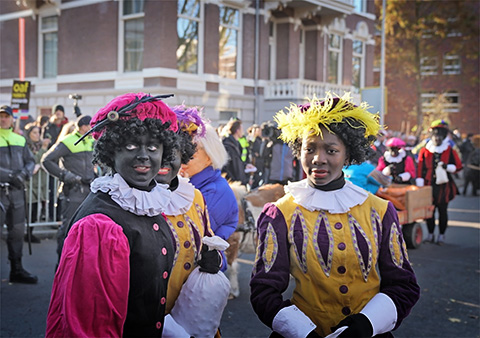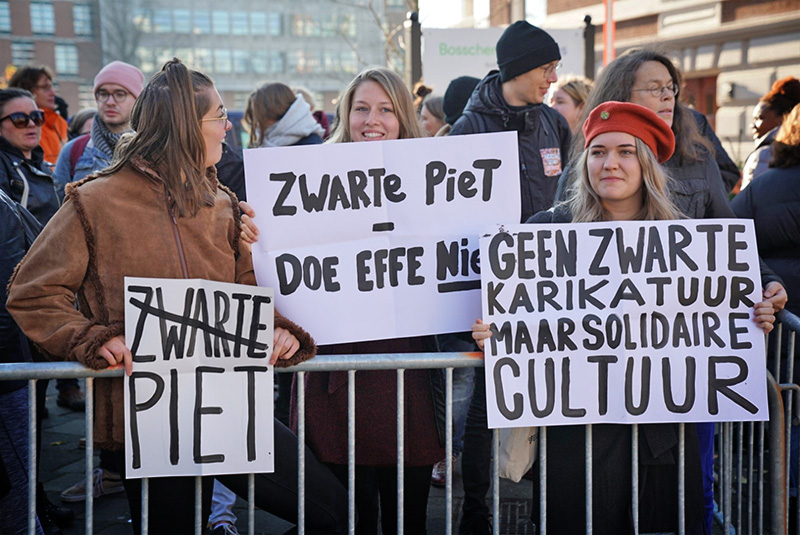
Black, purple, or soot marks?
We can’t make up our minds
What this research shows, and what it doesn’t
198 people out of 30,000 students and 6,000 employees is not a large sample. We also don’t know enough about our survey to make any claims about how representative it is; we didn’t ask for age or gender; not all faculties were included; and we certainly didn’t get all the service facilities or departments.
We’re certainly not claiming that our research is scientifically sound. It’s just a poll. But because we’re asking pretty much the same questions we did two and four years ago, of both Dutch people and internationals spread across various faculties and buildings, we can compare the results to those of earlier years.
It’s almost become as much of a tradition as the Zwarte Piet discussion itself: the regular UKrant poll where we try to figure out how the RUG community feels about Piet. We first questioned one hundred staff and students about the country’s most hot button issue in 2014. In 2016, we held the poll once again.
Now, in 2018, it feels as though public opinion is slowly moving towards an anti-Zwarte Piet stance. The majority of people no longer get defensive at the idea that the blackface paint may be hurtful, problematic, or racist. At the same time, media coverage makes the pro-side seem to be increasingly made up of hooligans and far-right extremists.
As the poll showed, the RUG saw a clear shift between 2014 and 2016. In 2014, more than half the respondents said they were for a traditional, black Zwarte Piet. Two years later, less than a third was still in favour of this. The percentage of opponents raised from 30 to 37. Everyone else said they didn’t really have an opinion either way.
Old-fashioned
This year we spoke to 198 students and staff. Of those, 34.5 percent said they were for Zwarte Piet with a traditional, fully black face. 33 percent were against it, saying the concept is hurtful, old-fashioned, or racist. The other 32.5 percent of respondents weren’t sure how they felt. The actual numbers are as follows: 68 people are for, 65 are against, and 64 respondents are unsure. Oh, and one person forgot to check the necessary box.
This means there hasn’t been a significant shift in anti-black Zwarte Piet sentiments at the RUG. Compared to last year, the number of proponents for blackfaced-Piet has only slightly increased, while there are a tad fewer opponents.
Proponents mainly cite the festival being for children as the reason for their stance. ‘Children see Piet as someone who comes through the chimney’, one of the respondents writes. They also argue the importance of tradition. ‘Zwarte Piet has always been like this. It’s not harming anyone and it’s not meant to be discriminatory’, one respondent said. ‘Why is Zwarte Piet a discussion now? We never talked about it before’, another wondered.
Small adjustments
Opponents point out that there are definitely people who feel Zwarte Piet is racist, and that it hurts them. ‘If a large group of Dutch people are uncomfortable, that’s a good reason to make small adjustments’, one person wrote. It wouldn’t even have to be all that drastic, another respondent said: ‘Even without the fully black faces, the essence is still safeguarded.’
There is a clear difference of opinion between Dutch people and internationals. Of the Dutch respondents, who grew up with songs, television programmes, and school festivals full of fully black Pieten, half argued for keeping Zwarte Piet black. A little more than 20 percent wants to get rid of Zwarte Piet, and almost 30 percent don’t know.
Among the internationals, the majority (49.4 percent) are against Zwarte Piet. A little less than 15 percent said he can stay, while 35 percent were neutral on the issue.
There has been an interesting shift in that neutral position. In 2014 there were fewer people who checked the ‘no opinion’ box (20 percent versus 32.5) and they often truly didn’t have an opinion or weren’t willing to express one. ‘I simply don’t care’, said one of the respondents back then, who was ‘so over the discussion.’
Positive tradition
This year, many people indicated they thought the issue was complicated. The box ‘no opinion’ was often checked by people who weren’t sure how to feel about it, or who understood both sides of the issue.
‘I personally never saw the link between Zwarte Piet and people of colour’, one person said. ‘But I don’t want people to feel hurt, so I think we should accommodate them. What bothers me is that people who don’t think Zwarte Piet is racist (because they grew up with him and have a different outlook) are immediately seen as racists themselves.’
One Greek student said they understood why people of colour are offended by Zwarte Piet. ‘But I’m not Dutch, and I can also see how it is a positive tradition for Dutch people.’ A student from Slovakia suggested that the RUG should use rainbow Pieten for university celebrations.
What should change?
A 49.7 percent majority of the respondents agree that the appearance of the Pieten should change, but those respondents are divided as to how he should change. 35 percent want the blackface to go altogether: they only want to see soot marks or rainbow colours. 12 percent suggested keeping the black paint but toning down the stereotypical aspects of Piet’s look; no more big red lips, large golden earrings, or huge afros.
32.6 of the remaining respondents don’t want Piet to change at all; the rest don’t care.
According to a German student, Zwarte Peit isn’t really even necessary for the Sinterklaas celebration. ‘We used to have a similar tradition in Germany, with the helper Ruprecht. But we simply don’t celebrate that part anymore, and focus only on Sinterklaas.’
In 2018, the RUG is almost perfectly divided into three camps. This shows – at the very least – that the anti-Zwarte Piet people aren’t just a whiny bunch of marginalised snowflakes, and the pro-group aren’t just made up of highway-blocking Frisians and yelling hooligans. People on both sides are giving the issue careful thought as the tradition faces increasing criticism. Might we be reaching a tipping point? Which side will prevail?
We’ll let you know in 2020.
What does a typical Sinterklaas celebration look like at the RUG?
Some departments at the RUG organise their own Sinterklaas celebrations for staff and their children. There is no central university policy about what this should look like, and the departments are free to do as they see fit.
The UMCG follows the example set by the Dutch Sinterklaas news, a spokesperson says. ‘We’ve been doing this for a few years now. This year, I think this means we’ll have a combination of Pieten with soot marks and Pieten who went down the chimney so often they became completely black.’
Staff association De Brug celebrates Sinterklaas at film theatre Pathé. Staff and their children get to watch the film Sinterklaas en de vlucht door de lucht. The Pieten in that film do have some dark paint on their faces, but don’t look like stereotypes. ‘Last year there were soot-Pieten’, says Jaap van der Linde with the association. ‘I’m not sure what they’ll look like this year, that’s up to Pathé.’
The Faculty of Economics and Business has been experimenting over the past few years, says organiser Aafke Wiekens. ‘Two years ago we had a gold Piet and a purple Piet, but we didn’t like the purple one much. So this year we’ll have a gold Piet and one with soot marks.’ One thing the Pieten at FEB will certainly not be is blackfaced. ‘We want to serve everyone and make the celebration as inclusive as possible. I feel we’ve succeeded at that.’


